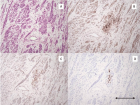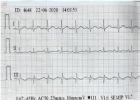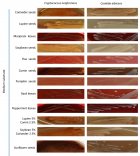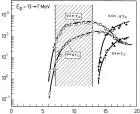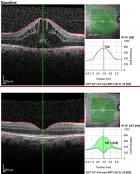Abstract
Research Article
Associations of Exercise Habits and Circulatory Dynamics with Peripheral Lower Limb Body Composition in Healthy Community-dwelling Older Individuals
Haruki Kogo*, Yuh Yamashita and Jun Murata
Published: 15 April, 2022 | Volume 3 - Issue 1 | Pages: 027-034
We investigated the associations between circulatory dynamics and Body Composition (BC) of the peripheral lower limbs with Exercise Habits (EHs). We surveyed the EHs of 34 healthy older adults (6 men, 28 women) and measured their BC and skin perfusion (SP). SP did not correlate significantly with any other variable. Participants with established EHs had a lower body weight and Fat Tissue thickness (Fat-T) than those without. Multiple logistic regressions with the presence or absence of an EH as the dependent variable and BC values as the independent variables established Fat-T as a significant variable. Sex was independently associated with soleus muscle thickness, Fat-T, Bone Density (BD), and leg segmental water. Age was independently associated with Fat-T and BD, and body mass index was associated with Fat-T. EHs were not independently associated with any of the BC measurements. Physical characteristics and EHs have minimal influence on peripheral circulatory dynamics.
Read Full Article HTML DOI: 10.29328/journal.jcmhs.1001017 Cite this Article Read Full Article PDF
Keywords:
Skin perfusion; Physical characteristics; Muscle thickness; Fat thickness; Older adults
References
- Miyabara H, Takeshita J. The relation of exercise performance with healthy life span in the community dwelling elderly––a 3 year follow-up study. J Japanese Phys Ther Soc 2004; 31: 155-159.
- Ministry of Health, Labour, and Welfare. Examining mean life expectancy and healthy life expectancy 2020.
- Okazaki K. The way to extend our healthy life span. J Japanese Physiol Anthropol Soc. 2017; 22: 39-44.
- Takei M. Health promotion through exercise: - Easy to walk, I’m fine today. Japanese J Juntendo Egaku. 2002; 48: 330-334.
- Tsushita I. Prospects for health and medical strategies from fiscal 2018 onward based on the effects and challenges of specific health checks and specific health guidance. Journal of Japan Society of Ningen Dock. 2016; 31: 7-21.
- Saito S. What is locomotive syndrome? Nichidai Igaku Zasshi. 2015; 74: 122-127.
- Uemura K, Yamada M, Okamoto H. Effects of health education intervention through active learning for preventing frailty in older adults. Phys Ther Japan. 2018; 45: 209-217.
- Yoshida N, Nakamura K, Kawai H, Hoshino K, Kume S. Comparison of 2nd fiscal year’s medical checkup results between examinees who received specific health guidance for metabolic syndrome and those who received no guidance. J Japan Soc Ningen Dock. 2012; 27: 707-714.
- Imawatari R, Ogawa M, Hamao Y, Kitahara N, Uno T, et al. Study on changes in various indicators due to specific health guidance. J Japan Soc Ningen Dock. 2011; 26: 44-50.
- Fukasaku T, Okuno J, Tomura S, Seino S, Kim MJ, et al. Intervention effects of inclusive support in an “exercise and a nutritional community-based prevention program” for pre-frail elderly individuals. Nihon Koshu Eisei Zasshi. 2011; 58: 420-432. PubMed: https://pubmed.ncbi.nlm.nih.gov/21970076/
- Yumura R, Ishibashi H, Fujita H. Association of fall history with locomotive syndrome severity test and motor function measurements in community-dwelling middle-aged and elderly people. Rigaku-Ryouhou Rinnsyou Kenkyuu Kyouiku. 2016; 23: 40-46.
- Arai T, Obuchi S, Kojima M, Matumoto Y, Inaba Y. The evaluation of the relationships between physical factors and effects of exercise intervention on physical functions in community-dwelling older people. Nihon Ronen Igakkai Zasshi. 2006; 43: 781-788. PubMed: https://pubmed.ncbi.nlm.nih.gov/17233465/
- Arai T, Fujita H, Hosoi T, Morita Y, Ishibashi H. Toe flexor muscle strength as a measure of motor function in community-dwelling elderly people. J Japanese Phy Ther Soc. 2011; 38: 489-496.
- Perkisas S, Baudry S, Bauer J, Beckwée D, De Cock A, et al. Application of ultrasound for muscle assessment in sarcopenia: towards standardized measurements. Eur Geriatr Med. 9: 739-757. PubMed: https://pubmed.ncbi.nlm.nih.gov/34674473/
- Waki H. Symposium 1-11: Central breathing, circulation, and thermoregulation mechanisms during exercises—Understanding the black box. Japanese J Phys Fit Sports Med. 2013; 62: 17-61.
- Kenney WL. Control of heat-induced cutaneous vasodilatation in relation to age. Eur J Appl Physiol Occup Physiol. 1988; 57: 120-125. PubMed: https://pubmed.ncbi.nlm.nih.gov/3342787/
- Kenney WL, Havenith G. Heat stress and age: skin blood flow and body temperature. J Therm Biol. 1993; 18: 341-344.
- Drinkwater BL, Bedi JF, Loucks AB, Roche S, Horvath SM. Sweating sensitivity and capacity of women in relation to age. J Appl Physiol Respir Environ Exerc Physiol. 1982; 53: 671-676. PubMed: https://pubmed.ncbi.nlm.nih.gov/7129989/
- Slentz CA, Duscha BD, Johnson JL, Ketchum K, Aiken LB, et al. Effects of the amount of exercise on body weight, body composition, and measures of central obesity: STRRIDE--a randomized controlled study. Arch Intern Med. 2004; 164: 31-39. PubMed: https://pubmed.ncbi.nlm.nih.gov/14718319/
- Imai Y, Kubo A. Relationships between body composition and nutrition in young females. Rigakuryoho Kagaku. 2019; 34: 713-717.
- Abe T, Kumagai K, Brechue WF. Fascicle length of leg muscles is greater in sprinters than distance runners. Med Sci Sports Exerc. 2000; 32: 1125-1129. PubMed: https://pubmed.ncbi.nlm.nih.gov/10862540/
- Akagi R, Chino K, Dohi M, Takahashi H. Relationships between muscle size and hardness of the medial gastrocnemius at different ankle joint angles in young men. Acta Radiologica. 2012; 53: 307-311. PubMed: https://pubmed.ncbi.nlm.nih.gov/22302209/
- Fukumoto Y, Ikezoe T, Yamada Y, Ichihashi N. Assessment of muscle quantity and quality with ultrasonography. Phys Ther Japan.2015; 42: 65-71.
- Kogo H, Yamashita Y. Characteristics of the rotator cuff muscle thickness in baseball players using ultrasound images. Japanese J Health Promot Phys Ther. 2020; 9: 187-193.
- Kubo A, Tanaka S, Ookawa H, Murata S. Locomotive syndrome among middle-aged females, the characteristics of their body composition and their physical ability. Japanese J Health Promot Phys Ther. 2019; 9: 19-23.
- Sasaki N, Ueno K, Shiraishi T, Kuno M, Nakazawa E, et al. Assessment of body fluid component in hemodialyzed patients using a body composition analyzer (InBody S20): can the bioelectrical impedance method be a marker of dry weight? Nihon Toseki Igakkai Zasshi. 2007; 40: 581-588.
- Abe T, Sakamoto M, Yasuda T, Bemben MG, Kondo M, et al. Age-related, site-specific muscle loss in 1507 Japanese men and women aged 20 to 95 years. J Sports Sci Med. 2011; 10: 145-150. PubMed: https://pubmed.ncbi.nlm.nih.gov/24149307/
- Arai T. Correlations among obesity index, body mass index, percent body fat and other clinical signs. Evaluations of obesity as the risk factor for various diseases. Kenkou igaku, Japanese J Health Med. 1999; 14: 168-173.
- Yokouchi J, Ando D, Ono Y, Ozaki Y, Asakawa K, et al. Influence of anthropometric measures and lifestyle-related factors on the two-year changes of bone mass in college-aged women. Japanese J Phys Fit Sports Med. 2006; 55: 331-340.
- Khosla S, Atkinson EJ, Riggs BL, Melton LJ. Relationship between body composition and bone mass in women. J Bone Miner Res. 1996; 11: 857-863. PubMed: https://pubmed.ncbi.nlm.nih.gov/8725184/
- Harris SS, Dawson-Hughes B. Weight, body composition, and bone density in postmenopausal women. Calcif Tissue Int. 1996; 59: 428-432. PubMed: https://pubmed.ncbi.nlm.nih.gov/8939766/
- Sakai R, Yamada S, Nima Y, Hamasaki T, Dewake N, et al. Relation between nutritional-health status and the current-past medical history in elderly outpatients. Part 1. Journal of the Japan Dietetic Association. 2014; 57: 28-37.
- Muraoka Y, Komiya S. Equation for estimating total body water by bioelectrical impedance measurements in Japanese subjects. The Ann Physiol Anthropol. 1991; 10: 203-210. PubMed: https://pubmed.ncbi.nlm.nih.gov/1810307/
- Ozawa T, Fukuda K. (supervising editor). Hyojun seirigaku. Tokyo: Igaku-Shoin Ltd. 2014; 874-876.
- Maeda S, Date Y, Nishimura T, Niimura M, Hayashi M, et al. Relationship between core temperature and physiological measurement during incremental load test under hot environment-basic research for preventing heat stroke. J Japanese Physiol Anthropol Soc. 2018; 23: 155-163.
- Ueno S. Relationship between aging and thermoregulation. Japanese Journal of Occupational Medicine and Traumatology 2016; 64: 308-318.
- Tankersley CG, Smolander J, Kenney WL, Fortney SM. Sweating and skin blood flow during exercise: effects of age and maximal oxygen uptake. J Appl Physiol. 1991; 71: 236-242. PubMed: https://pubmed.ncbi.nlm.nih.gov/1917747/
- Lee HY, Oh BH. Aging and arterial stiffness. Circ J. 2010; 74: 2257-2262. PubMed: https://pubmed.ncbi.nlm.nih.gov/20962429/
- Di Iorio A, Di Blasio A, Napolitano G, Ripari P, Paganelli R, et al. High fat mass, low muscle mass, and arterial stiffness in a population of free-living healthy subjects: the “al passo con la tua salute” project. Medicine. 2019; 98: e16172. PubMed: https://pubmed.ncbi.nlm.nih.gov/31261548/
- Ajisaka R. Health maintenance and exercise training in the elderly. Nihon Ronen Igakkai Zasshi. 43: 585-587. PubMed: https://pubmed.ncbi.nlm.nih.gov/17073282/
- Franklin SS, Gustin W, Wong ND, Larson MG, Weber MA, et al. Hemodynamic patterns of age-related changes in blood pressure. The Framingham Heart Study. Circulation. 1997; 96: 308-315. PubMed: https://pubmed.ncbi.nlm.nih.gov/9236450/
- Matsuda M. Exercise and prevention of arteriosclerosis in elderly people: effects of exercise on aging changes in central arterial distensibility. Japanese J Phys Fit Sports Med. 2003; 52: 31-37.
- Shimizu R, Hotta K, Yamamoto S, Matsumoto T, Kamiya K, et al. Low-intensity resistance training with blood flow restriction improves vascular endothelial function and peripheral blood circulation in healthy elderly people. Eur J Appl Physiol. 2016; 116: 749-757. PubMed: https://pubmed.ncbi.nlm.nih.gov/26822582/
- Proctor DN, Shen PH, Dietz NM, Eickhoff TJ, Lawler LA, et al. Reduced leg blood flow during dynamic exercise in older endurance-trained men. J Appl Physiol. 1998; 85: 68-75. PubMed: https://pubmed.ncbi.nlm.nih.gov/9655757/
- Adams TD, Heath EM, LaMonte MJ, Gress RE, Pendleton R, et al. The relationship between body mass index and per cent body fat in the severely obese. Diabetes Obes Metab 2007; 9: 498-505. PubMed: https://pubmed.ncbi.nlm.nih.gov/17587392/
Figures:
Similar Articles
-
Associations of Exercise Habits and Circulatory Dynamics with Peripheral Lower Limb Body Composition in Healthy Community-dwelling Older IndividualsHaruki Kogo*,Yuh Yamashita,Jun Murata. Associations of Exercise Habits and Circulatory Dynamics with Peripheral Lower Limb Body Composition in Healthy Community-dwelling Older Individuals. . 2022 doi: 10.29328/journal.jcmhs.1001017; 3: 027-034
-
Senile CataractRagni Kumari*. Senile Cataract. . 2024 doi: 10.29328/journal.jcmhs.1001041; 5: 001-007
Recently Viewed
-
Misoprostol Usage in the Kingdom of Bahrain: A Retrospective StudyMaryam Alsalem*,Hosni Malas,Gulmeen Raza,Rehab Ismael. Misoprostol Usage in the Kingdom of Bahrain: A Retrospective Study. Clin J Obstet Gynecol. 2025: doi: 10.29328/journal.cjog.1001196; 8: 092-095
-
The role of denial on emotional correlates of childhood trauma in a non-clinical populationSanja Krvavac*,Billy Jansson. The role of denial on emotional correlates of childhood trauma in a non-clinical population. Arch Psychiatr Ment Health. 2022: doi: 10.29328/journal.apmh.1001043; 6: 040-047
-
Role of toll-like receptors and their ligands in adipocyte secretionA Mishra*,AV Shestopalov,AM Gaponov,IA Alexandrov,SA Roumiantsev. Role of toll-like receptors and their ligands in adipocyte secretion. Ann Proteom Bioinform. 2021: doi: 10.29328/journal.apb.1001012; 5: 001-007
-
Pigeonpea sterility mosaic virus a green plague-Current status of available drug and new potential targetsNisha Singh*,Bhawna Narula,Megha Ujinwal,Sapna Langyan. Pigeonpea sterility mosaic virus a green plague-Current status of available drug and new potential targets. Ann Proteom Bioinform. 2021: doi: 10.29328/journal.apb.1001013; 5: 008-026
-
The SARS CoV-2 spike domain, RGD and integrin binding effect-relationship for vaccine design strategyLuisetto M*,Tarro G,Khaled Edbey,Almukthar N,Cabianca L,Mashori GR,Yesvi AR,Latyschev OY. The SARS CoV-2 spike domain, RGD and integrin binding effect-relationship for vaccine design strategy. Ann Proteom Bioinform. 2021: doi: 10.29328/journal.apb.1001014; 5: 027-041
Most Viewed
-
Feasibility study of magnetic sensing for detecting single-neuron action potentialsDenis Tonini,Kai Wu,Renata Saha,Jian-Ping Wang*. Feasibility study of magnetic sensing for detecting single-neuron action potentials. Ann Biomed Sci Eng. 2022 doi: 10.29328/journal.abse.1001018; 6: 019-029
-
Evaluation of In vitro and Ex vivo Models for Studying the Effectiveness of Vaginal Drug Systems in Controlling Microbe Infections: A Systematic ReviewMohammad Hossein Karami*, Majid Abdouss*, Mandana Karami. Evaluation of In vitro and Ex vivo Models for Studying the Effectiveness of Vaginal Drug Systems in Controlling Microbe Infections: A Systematic Review. Clin J Obstet Gynecol. 2023 doi: 10.29328/journal.cjog.1001151; 6: 201-215
-
Causal Link between Human Blood Metabolites and Asthma: An Investigation Using Mendelian RandomizationYong-Qing Zhu, Xiao-Yan Meng, Jing-Hua Yang*. Causal Link between Human Blood Metabolites and Asthma: An Investigation Using Mendelian Randomization. Arch Asthma Allergy Immunol. 2023 doi: 10.29328/journal.aaai.1001032; 7: 012-022
-
Impact of Latex Sensitization on Asthma and Rhinitis Progression: A Study at Abidjan-Cocody University Hospital - Côte d’Ivoire (Progression of Asthma and Rhinitis related to Latex Sensitization)Dasse Sery Romuald*, KL Siransy, N Koffi, RO Yeboah, EK Nguessan, HA Adou, VP Goran-Kouacou, AU Assi, JY Seri, S Moussa, D Oura, CL Memel, H Koya, E Atoukoula. Impact of Latex Sensitization on Asthma and Rhinitis Progression: A Study at Abidjan-Cocody University Hospital - Côte d’Ivoire (Progression of Asthma and Rhinitis related to Latex Sensitization). Arch Asthma Allergy Immunol. 2024 doi: 10.29328/journal.aaai.1001035; 8: 007-012
-
An algorithm to safely manage oral food challenge in an office-based setting for children with multiple food allergiesNathalie Cottel,Aïcha Dieme,Véronique Orcel,Yannick Chantran,Mélisande Bourgoin-Heck,Jocelyne Just. An algorithm to safely manage oral food challenge in an office-based setting for children with multiple food allergies. Arch Asthma Allergy Immunol. 2021 doi: 10.29328/journal.aaai.1001027; 5: 030-037

If you are already a member of our network and need to keep track of any developments regarding a question you have already submitted, click "take me to my Query."








